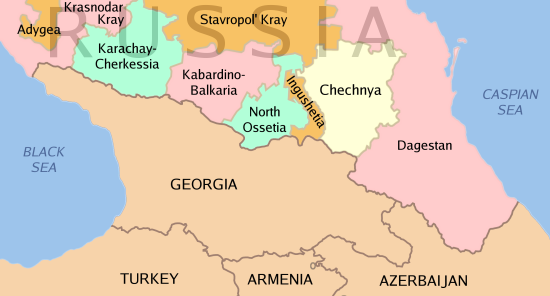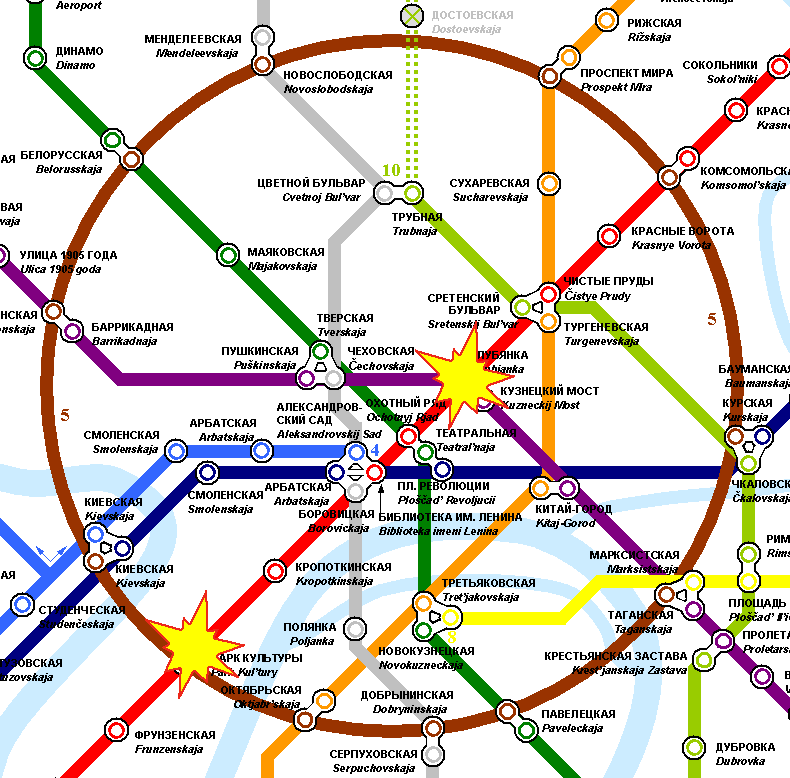|
Domodedovo International Airport Bombing
The Domodedovo International Airport bombing was a suicide bombing in the international arrival hall of Moscow's Domodedovo International, in Domodedovsky District, Moscow Oblast, on 24 January 2011. The bombing killed 37 people and injured 173 others, including 86 who had to be hospitalised. Of the casualties, 31 died at the scene, three later in hospitals, one en route to a hospital, one on 2 February after having been put in a coma, and another on 24 February after being hospitalised in grave condition. Russia's Federal Investigative Committee later identified the suicide bomber as a 20-year-old from the North Caucasus, and said that the attack was aimed "first and foremost" at foreign citizens. Background Domodedovo International is located southeast of central Moscow and is Russia's second largest airport, with over 22 million passengers passing through in 2010. It is heavily used by foreign workers and tourists. In 2004, two aircraft which had just taken off from D ... [...More Info...] [...Related Items...] OR: [Wikipedia] [Google] [Baidu] |
Insurgency In The North Caucasus
The insurgency in the North Caucasus (russian: Борьба с терроризмом на Северном Кавказе) was a low-level armed conflict between Russia and militants associated with the Caucasus Emirate and, from June 2015, Islamic State (IS) groups in the North Caucasus. It followed the official end of the decade-long Second Chechen War on 16 April 2009. It attracted people from the Middle East, North Africa, Europe, and Central Asia, who then participated in the conflict, but volunteers from the North Caucasus were also fighting in Syria. The insurgency became relatively dormant in its later years. During its peak, the violence was mostly concentrated in the North Caucasus republics of Chechnya, Dagestan, Ingushetia and Kabardino-Balkaria. Occasional incidents happened in surrounding regions, like North Ossetia–Alania, Karachay-Cherkessia, Stavropol Krai and Volgograd Oblast. The insurgency was officially declared over on 19 December 2017 after more th ... [...More Info...] [...Related Items...] OR: [Wikipedia] [Google] [Baidu] |
Moscow Metro
The Moscow Metro) is a metro system serving the Russian capital of Moscow as well as the neighbouring cities of Krasnogorsk, Reutov, Lyubertsy and Kotelniki in Moscow Oblast. Opened in 1935 with one line and 13 stations, it was the first underground railway system in the Soviet Union. , the Moscow Metro, excluding the Moscow Central Circle, the Moscow Central Diameters and the Moscow Monorail, has 250 stations (287 with Moscow Central Circle) and its route length is , making it the fifth-longest in the world and the longest outside China. The system is mostly underground, with the deepest section underground at the Park Pobedy station, one of the world's deepest underground stations. It is the busiest metro system in Europe, and is considered a tourist attraction in itself. Operations The Moscow Metro, a state-owned enterprise, is long and consists of 15 lines and 250 stations organized in a spoke-hub distribution paradigm, with the majority of rail lines running ... [...More Info...] [...Related Items...] OR: [Wikipedia] [Google] [Baidu] |
CACI
CACI International Inc. (originally California Analysis Center, Inc., then Consolidated Analysis Center, Inc.) is an American multinational professional services and information technology company headquartered in Northern Virginia. CACI provides services to many branches of the US federal government including defense, homeland security, intelligence, and healthcare. CACI has approximately 23,000 employees worldwide. CACI is a member of the Fortune 1000 Largest Companies, the Russell 2000 index, and the S&P MidCap 400 Index. History CACI was founded by Herb Karr and Harry Markowitz, who left RAND Corporation in 1962 to commercialize the SIMSCRIPT simulation programming language. The company went public in 1968. "CACI", which was originally an acronym for "California Analysis Center, Incorporated", was changed to stand for "Consolidated Analysis Center, Incorporated" in 1967. In 1973, the acronym alone was adopted as the firm's official name; reflecting the name customers h ... [...More Info...] [...Related Items...] OR: [Wikipedia] [Google] [Baidu] |
Ministry Of Emergency Situations (Russia)
The Ministry of the Russian Federation for Civil Defence, Emergency Situations and Elimination of Consequences of Natural Disasters (russian: Министерство Российской Федерации по делам гражданской обороны, чрезвычайным ситуациям и ликвидации последствий стихийных бедствий), also known as the Ministry of Emergency Situations (; abbreviated MChS, ) or internationally as EMERCOM (derived from "Emergency Control Ministry"), is a Russian government agency overseeing the civil emergency services in Russia. President Boris Yeltsin established EMERCOM on January 10, 1994, though the ministry can be traced back to December 27, 1990, when the Russian Soviet Federative Socialist Republic (RSFSR) established the Russian Rescue Corps and assigned it the mission of rapid response to emergencies. History The history of civil defence services in Russia traces to the years of Musc ... [...More Info...] [...Related Items...] OR: [Wikipedia] [Google] [Baidu] |
Odessa
Odesa (also spelled Odessa) is the third most populous city and municipality in Ukraine and a major seaport and transport hub located in the south-west of the country, on the northwestern shore of the Black Sea. The city is also the administrative centre of the Odesa Raion and Odesa Oblast, as well as a multiethnic cultural centre. As of January 2021 Odesa's population was approximately In classical antiquity a large Greek settlement existed at its location. The first chronicle mention of the Slavic settlement-port of Kotsiubijiv, which was part of the Grand Duchy of Lithuania, dates back to 1415, when a ship was sent from here to Constantinople by sea. After a period of Lithuanian Grand Duchy control, the port and its surroundings became part of the domain of the Ottomans in 1529, under the name Hacibey, and remained there until the empire's defeat in the Russo-Turkish War of 1792. In 1794, the modern city of Odesa was founded by a decree of the Russian empress Catherin ... [...More Info...] [...Related Items...] OR: [Wikipedia] [Google] [Baidu] |
Anna Yablonskaya
Hanna Hryhorivna Mashutina ( ua, Га́нна Григо́рівна Машу́тіна; July 20, 1981 – January 24, 2011), known under her pseudonyms Anna Yablonskaya (russian: А́нна Ябло́нская) or Hanna Yablonska ( ua, Га́нна Ябло́нська), was a Ukrainian playwright and poet, and one of the victims of the 2011 Domodedovo International Airport bombing. Profile Yablonska was born in Odessa, Ukrainian SSR (now Ukraine). Under the pseudonym Anna Yablonskaya (russian: Анна Яблонская) she published over a dozen Russian-language playscripts. Many of them were staged at venues in Russia, in particular, in St. Petersburg. Since 2004 Yablonska received several awards in different literary and dramatic events in Russia (Moscow, Yekaterinburg) and Belarus (Minsk). She also wrote a series of lyrical poems.П ... [...More Info...] [...Related Items...] OR: [Wikipedia] [Google] [Baidu] |
Accomplice
Under the English common law, an accomplice is a person who actively participates in the commission of a crime, even if they take no part in the actual criminal offense. For example, in a bank robbery, the person who points the gun at the teller and demands the money is guilty of armed robbery. Anyone else directly involved in the commission of the crime, such as the lookout or the getaway car driver, is an accomplice, even if in the absence of an underlying offense keeping a lookout or driving a car would not be an offense. An accomplice differs from an accessory in that an accomplice is present at the actual crime, and could be prosecuted even if the main criminal (the '' principal'') is not charged or convicted. An accessory is generally not present at the actual crime, and may be subject to lesser penalties than an accomplice or principal. At law, an accomplice has the same degree of guilt as the person(s) who committed the underlying crime, and is subject to the same le ... [...More Info...] [...Related Items...] OR: [Wikipedia] [Google] [Baidu] |
Trinitrotoluene
Trinitrotoluene (), more commonly known as TNT, more specifically 2,4,6-trinitrotoluene, and by its preferred IUPAC name 2-methyl-1,3,5-trinitrobenzene, is a chemical compound with the formula C6H2(NO2)3CH3. TNT is occasionally used as a reagent in chemical synthesis, but it is best known as an explosive material with convenient handling properties. The explosive yield of TNT is considered to be the standard comparative convention of bombs and asteroid impacts. In chemistry, TNT is used to generate charge transfer salts. History TNT was first prepared in 1863 by German chemist Julius Wilbrand and originally used as a yellow dye. Its potential as an explosive was not recognized for three decades, mainly because it was too difficult to detonate because it was less sensitive than alternatives. Its explosive properties were first discovered in 1891 by another German chemist, Carl Häussermann. TNT can be safely poured when liquid into shell cases, and is so insensitive that ... [...More Info...] [...Related Items...] OR: [Wikipedia] [Google] [Baidu] |
Shrapnel Shell
Shrapnel shells were anti-personnel artillery munitions which carried many individual bullets close to a target area and then ejected them to allow them to continue along the shell's trajectory and strike targets individually. They relied almost entirely on the shell's velocity for their lethality. The munition has been obsolete since the end of World War I for anti-personnel use; high-explosive shells superseded it for that role. The functioning and principles behind Shrapnel shells are fundamentally different from high-explosive shell fragmentation. Shrapnel is named after Lieutenant-General Henry Shrapnel (1761–1842), a British artillery officer, whose experiments, initially conducted on his own time and at his own expense, culminated in the design and development of a new type of artillery shell. Usage of term "shrapnel" has changed over time to also refer to fragmentation of the casing of shells and bombs. This is its most common modern usage, which strays from the o ... [...More Info...] [...Related Items...] OR: [Wikipedia] [Google] [Baidu] |
Suicide Attack
A suicide attack is any violent attack, usually entailing the attacker detonating an explosive, where the attacker has accepted their own death as a direct result of the attacking method used. Suicide attacks have occurred throughout history, often as part of a military campaign (as with the Japanese '' kamikaze'' pilots of 1944–1945 during World War II), and more recently as part of terrorist campaigns (such as the September 11 attacks in 2001). While few, if any, successful suicide attacks took place anywhere in the world from 1945 until 1980, between 1981 and September 2015 a total of 4,814 suicide attacks occurred in over 40 countries, killing over 45,000 people. During this time the global rate of such attacks grew from an average of three a year in the 1980s to about one a month in the 1990s to almost one a week from 2001 to 2003 to approximately one a day from 2003 to 2015. Suicide attacks tend to be more deadly and destructive than other terror attacks because ... [...More Info...] [...Related Items...] OR: [Wikipedia] [Google] [Baidu] |
2010 Moscow Metro Bombings
The 2010 Moscow Metro bombings were suicide bombings carried out by two Islamic female terrorists during the morning rush hour of March 29, 2010, at two stations of the Moscow Metro ( Lubyanka and Park Kultury), with roughly 40 minutes in between. At least 40 people were killed, and over 100 injured. Russian officials called the incident "the deadliest and most sophisticated terrorist attack in the Russian capital in six years", a reference to the Avtozavodskaya and Rizhskaya bombings in 2004. At the time of the attacks, an estimated 500,000 people were commuting through Moscow's metro system. Initial investigation indicated that the bombings were perpetrated by the militant Islamist Caucasus Emirate group. On March 31, Caucasus Emirate leader Doku Umarov claimed responsibility for ordering the attacks in a video released on the internet. He also stated that such attacks in Russia would continue unless Russia grants independence to Muslim states in the North Caucasus region ... [...More Info...] [...Related Items...] OR: [Wikipedia] [Google] [Baidu] |





